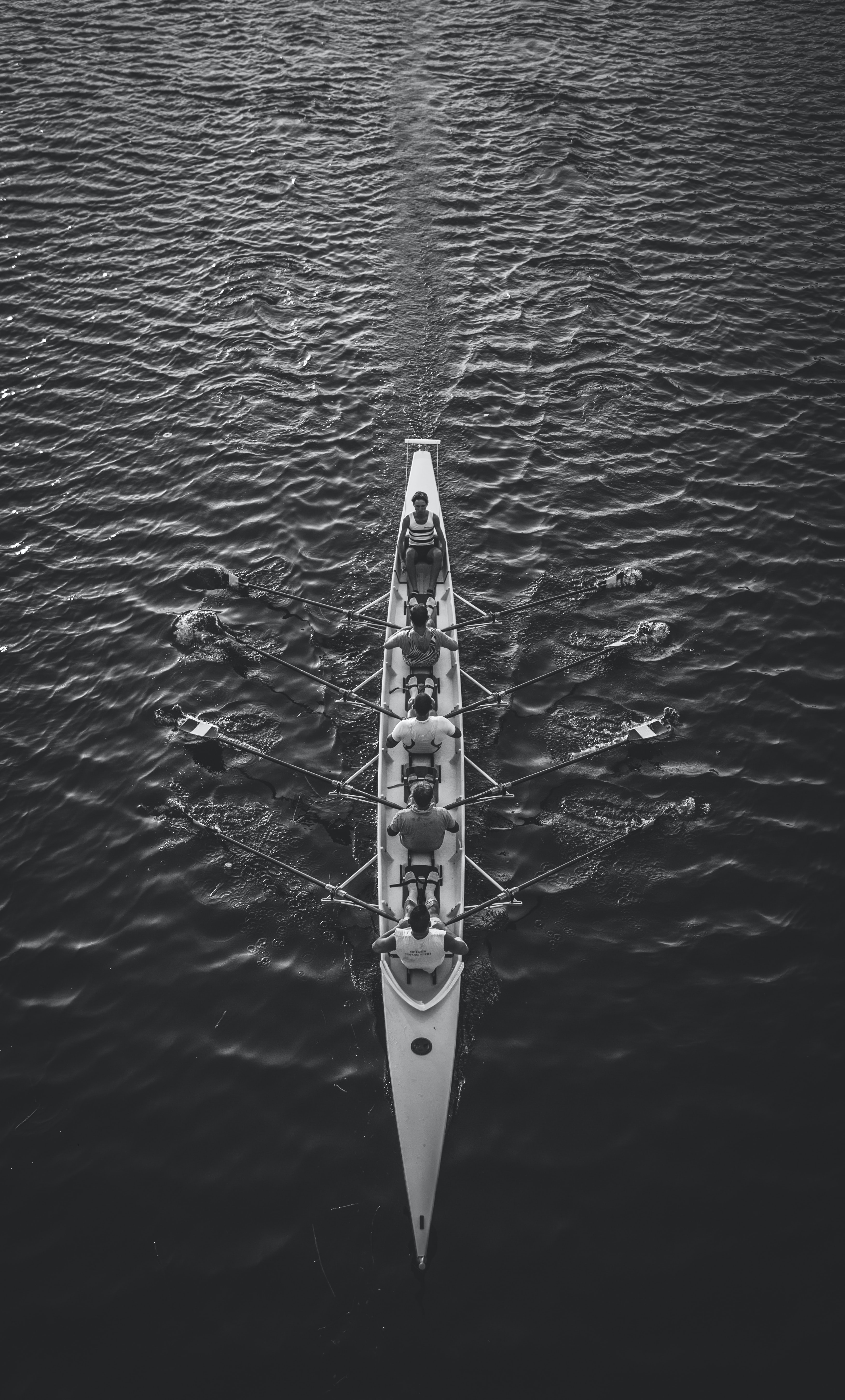Gunwale bobbing: Wave-driven propulsion!
 Gunwale bobbing is a phenomenon in which a person jumping on the gunwales of a canoe achieves horizontal propulsion by forcing it with vertical oscillations. The canoe moves forward by surfing the resulting wave-field.
After an initial transient, the canoe achieves a cruising velocity which satisfies a balance between the thrust generated from pushing downwards into the surface gradients of the wave-field and the resistance due to a combination of profile drag and wave drag. By superposing the linear wave theories of Havelock [1] for steady cruising and Helmholtz for an oscillating source, I demonstrated in a recent paper [2] that such a balance can be sustained. I calculated optimal parameter values to achieve maximum canoe velocity, and compared theoretical results to accelerometer data taken from an enthusiastic gunwale bobber (see GIF to the right) and to estimates from videos of other aficionados.
Interestingly, there are some similarities between gunwale bobbing and other examples of macroscopic wave-driven bodies (such as walking droplets), not to mention possible applications to competitive sports.
Gunwale bobbing is a phenomenon in which a person jumping on the gunwales of a canoe achieves horizontal propulsion by forcing it with vertical oscillations. The canoe moves forward by surfing the resulting wave-field.
After an initial transient, the canoe achieves a cruising velocity which satisfies a balance between the thrust generated from pushing downwards into the surface gradients of the wave-field and the resistance due to a combination of profile drag and wave drag. By superposing the linear wave theories of Havelock [1] for steady cruising and Helmholtz for an oscillating source, I demonstrated in a recent paper [2] that such a balance can be sustained. I calculated optimal parameter values to achieve maximum canoe velocity, and compared theoretical results to accelerometer data taken from an enthusiastic gunwale bobber (see GIF to the right) and to estimates from videos of other aficionados.
Interestingly, there are some similarities between gunwale bobbing and other examples of macroscopic wave-driven bodies (such as walking droplets), not to mention possible applications to competitive sports.
Waves and water sports
 Have you ever wondered why a kayak or a rowing boat is pointed at both the front and back? Whilst the point at the back makes the kayak more streamlined (similar to the tapered end of an airplane wing), the point at the front helps the boat slice through the water with minimal wave disturbance. Each of these aspects of the design are made to minimise wasted energy that could otherwise be used to make the boat go faster. But because these two sharp points have origins in two different physical phenomena, there is no reason for them to be symmetric. In other words, why not design a kayak with some front-back asymmetry?
Have you ever wondered why a kayak or a rowing boat is pointed at both the front and back? Whilst the point at the back makes the kayak more streamlined (similar to the tapered end of an airplane wing), the point at the front helps the boat slice through the water with minimal wave disturbance. Each of these aspects of the design are made to minimise wasted energy that could otherwise be used to make the boat go faster. But because these two sharp points have origins in two different physical phenomena, there is no reason for them to be symmetric. In other words, why not design a kayak with some front-back asymmetry?
There is a classical theory for predicting the drag due to wave generation, derived more than a century ago by J.H. Michell [3]. The major shortcoming of this formula is that, due to the reversibility of the steady potential flow formulation, it predicts no difference in the wave drag when an object with front-back asymmetry moves forwards or backwards. However, anyone who has tried to row a dinghy in the wrong direction would argue differently! In a recent paper [4], I presented several experimental observations investigating the effects of body asymmetry on wave drag, and showed that these effects can be replicated by modifying Michell’s theory to include the growth of a symmetry-breaking boundary layer. These results showed that for the parameter ranges relevant to rowing sports, it is advantageous to have a slightly more pointed leading edge than trailing edge, which is in accordance with modern sporting design.
Another factor which strongly affects the wave drag is the water depth. Olympic race courses have a minimum depth requirement of 3m, but with boats as long as 18m, rowers are likely to generate waves in both the deep (dispersive) and shallow (non-dispersive) regimes at various moments during a race. Entering from deep to shallow water is accompanied by a focusing of the wave drag near the shallow wave speed – and hence the emergence of co-existing fast and slow solution branches. In another recent paper [5] I described the non-linear dynamics of such motion, including possible bifurcation patterns and hysteresis routes during a race. Such effects have important implications in boat races, where different solution branches correspond to either competitive or non-competitive race performance.
[1] Havelock, T.H. Wave resistance: some cases of three-dimensional fluid motion., Proceedings of the Royal Society of London, A. 95.670, 354-365, (1919).
[2] Benham, G.P., Devauchelle, O., Morris, S.W., Neufeld, J.A. Gunwale bobbing. Physical Review Fluids, 7(7), p.074804. (2022).[pdf]
[3] Michell, J.H. The wave-resistance of a ship, The London, Edinburgh, and Dublin Philosophical Magazine and Journal of Science 45.272: 106-123, (1898).
[4] Benham, G.P., Boucher, J.P., Labbé, R., Benzaquen, M., Clanet, C. Wave drag on asymmetric bodies. Journal of Fluid Mechanics, 878, pp.147-168. (2019).[pdf]
[5] Benham, G.P., Bendimerad, R., Benzaquen, M., Clanet, C. Hysteretic wave drag in shallow water. Physical Review Fluids (2020).[pdf]
